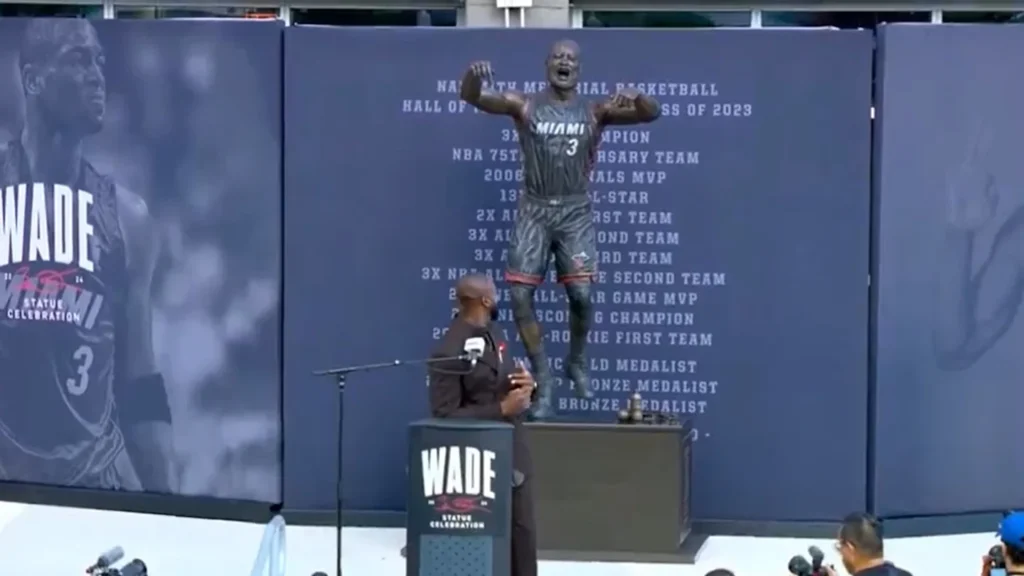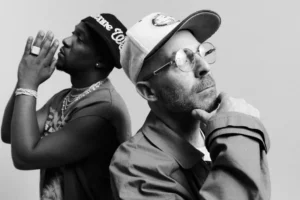The unveiling of Dwyane Wade’s statue outside the Miami Heat’s FTX Arena was meant to be a triumphant celebration of one of the franchise’s greatest players. Wade, a three-time NBA champion, 13-time All-Star, and arguably the best player in Miami Heat history, has left an indelible mark on the franchise and the city. However, the event quickly turned into a spectacle for NBA fans online, with many taking to social media to voice their opinions—not about Wade’s legacy, but about the statue itself.
The Unveiling
On February 21, 2023, the Miami Heat officially honored Wade by unveiling a life-sized bronze statue, which was designed to capture the essence of the player and his contributions to the team. The statue depicts Wade in his iconic “hang-time” pose, a moment that defined his explosive athleticism and unique style of play. Fans expected a masterpiece that would capture the essence of Wade’s greatness, much like the statues honoring other NBA legends around the league.
However, instead of heartfelt tributes, the unveiling prompted a wave of memes, jokes, and comparisons across social media platforms, sparking a fiery debate about the quality of the statue.
A Mixed Reception
The reactions to Wade’s statue were overwhelmingly mixed, with many fans and critics expressing disappointment. Comments ranged from playful jokes about the statue’s appearance to more serious critiques of its craftsmanship. Many noted that it lacked the lifelike quality that one might expect from a tribute to a player of Wade’s stature. The proportions appeared off, and the statue seemed to lack the necessary detail to do justice to the man it represented.
Fans shared side-by-side comparisons of the statue with Wade’s likeness and even noted how it failed to capture his trademark smile. Some joked that the statue looked more like a generic basketball player than the iconic figure who had inspired so many during his illustrious career. Memes flooded platforms like Twitter and Instagram, showcasing the statue alongside various pop culture figures, other athletes, and even cartoon characters, all in a bid to highlight its perceived shortcomings.
NBA Twitter’s Role
NBA Twitter, known for its humorous takes and sharp commentary, played a crucial role in the statue’s reception. Fans began sharing various reactions, many echoing a collective sentiment that the statue simply missed the mark. The platform’s culture thrives on humor and sarcasm, and the unveiling provided ample material for the usual suspects. Tweets highlighted everything from the statue’s expression (or lack thereof) to jokes about how it resembled other famous figures in sports and entertainment.
One viral tweet compared the statue to a character from the video game “NBA 2K,” suggesting it looked like an avatar that had not been fully rendered. Another suggested that the statue seemed to be suffering from a “midlife crisis,” a jab at how it appeared somewhat awkward and out of touch with the elegance of Wade’s playing style.
The Importance of Legacy
While the focus on the statue’s appearance dominated the conversation, it is essential to remember that Wade’s legacy extends far beyond any physical representation. He is known for his work ethic, his loyalty to the Heat, and his contributions to the game. Wade is not just a basketball player; he has become a cultural icon in Miami and beyond, using his platform to advocate for various social issues, including LGBTQ rights and education for underprivileged youth.
Nevertheless, the online backlash highlights an essential aspect of how athletes are remembered in the modern age. Statues, like Wade’s, are not just commemorative; they are statements that reflect the public’s perception of the athletes they honor. If a statue fails to resonate with fans, it can inadvertently tarnish the athlete’s image—at least in the eyes of a social media-savvy audience.
A Broader Conversation
The conversation surrounding Wade’s statue opened up a broader dialogue about the expectations for athlete memorials. How much should artistic interpretation play a role in these tributes? Should they be exact likenesses, or can they afford to be more abstract? In the case of Wade, many feel that his statue should embody the spirit and energy he brought to the game. Instead, it sparked jokes and memes, leading many to question whether artists and designers need to better understand their subjects.
Some fans have pointed to the need for better oversight in the creation of these memorials. If the goal is to honor an athlete, there should be a more involved process that allows the player’s family, teammates, and even fans to weigh in on how their loved one is represented. In Wade’s case, many believe that input from those who knew him best could have made a significant difference in how the statue turned out.
Impression
As the dust settles on the initial reaction to Wade’s statue, it serves as a lesson for franchises and artists alike. The criticism may seem harsh, but it reflects the passion that fans have for their heroes. In a sports landscape where athletes have become larger-than-life figures, the representations of them need to be equally compelling.
Moving forward, the Miami Heat may consider this experience as they plan future tributes or expansions of their arena. For now, Wade’s statue remains a topic of discussion—a blend of admiration for his achievements and frustration with how they have been physically represented.
The incident underscores a critical truth: statues are meant to last, and they carry the weight of an athlete’s legacy. As for Dwyane Wade, he continues to inspire both on and off the court. The debates and memes surrounding his statue will likely fade, but his impact on the game of basketball and the city of Miami will be felt for generations to come.
Ultimately, whether or not the statue is a fitting tribute, Dwyane Wade’s legacy remains intact—one that transcends bronze and captures the hearts of fans in a way that a mere statue never could.
No comments yet.







